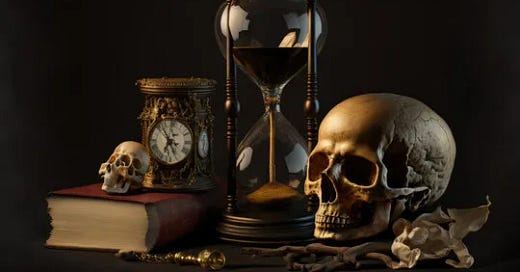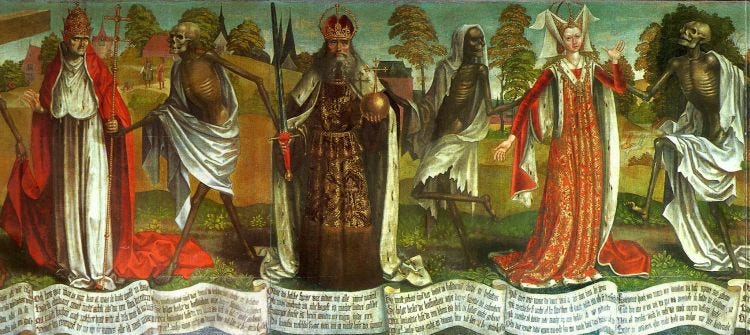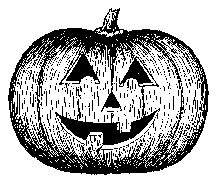Day 8 of the Novena for the Holy Souls
Plus a Novena for the Elections and a Blessed All Hallows Eve!
Pray the All Souls Novena once a day for nine days, starting on 24 October until the Eve of All Souls Day, which takes place on 2 November.
Day 8
Oh my God! I also am one of these ungrateful beings, having received so much grace, and yet despised Thy love and deserved to be cast by Thee into hell. But Thy infinite goodness has spared me until now. Therefore, I now love Thee above all things, and I am heartily sorry for having offended Thee. I will rather die than ever offend Thee. Grant me the grace of holy perseverance. Have compassion on me and, at the same time, on the holy souls suffering in Purgatory. Mary, Mother of God, come to their aid with thy powerful intercession.
Say one Our Father, one Hail Mary, and
The Prayer to Our Suffering Savior for the Holy Souls in Purgatory:
O most sweet Jesus, through the bloody sweat which Thou didst suffer in the Garden of Gethsemane, have mercy on these Blessed Souls. Have mercy on them.
R. Have mercy on them, O Lord.
O most sweet Jesus, through the pains which Thou didst suffer during Thy most cruel scourging, have mercy on them.
R. Have mercy on them, O Lord.
O most sweet Jesus, through the pains which Thou didst suffer in Thy most painful crowning with thorns, have mercy on them. R. Have mercy on them, O Lord.
O most sweet Jesus, through the pains which Thou didst suffer in carrying Thy cross to Calvary, have mercy on them.
R. Have mercy on them, O Lord.
O most sweet Jesus, through the pains which Thou didst suffer during Thy most cruel Crucifixion, have mercy on them.
R. Have mercy on them, O Lord.
O most sweet Jesus, through the pains which Thou didst suffer in Thy most bitter agony on the Cross, have mercy on them.
R. Have mercy on them, O Lord.
O most sweet Jesus, through the immense pain which Thou didst suffer in breathing forth Thy Blessed Soul, have mercy on them.
R. Have mercy on them, O Lord.
(Recommend yourself to the Souls in Purgatory and mention your intentions here).
Blessed Souls, I have prayed for thee; I entreat thee, who are so dear to God, and who are secure of never losing Him, to pray for me a miserable sinner, who is in danger of being damned, and of losing God forever.
Amen.
Join us in prayer in the lead-up to Election Day on November 5, 2024.
For the Social Reign of Christ the King, especially in our public life and by our earthly authorities and rulers.
For the election of leaders who uphold the Social Reign of Christ the King.
For Pro-Life victories in all state ballot elections.
For the conversion of all leaders to the One True Catholic Church, and for all governments to recognize Christ as King and conform their laws to His teachings.
O Christ Jesus, I acknowledge Thee to be the King of the Universe; all that has been made is created for Thee. Exercise over me all Thy sovereign rights. I hereby renew the promises of my baptism, renouncing Satan and all his works and pomps, and I engage myself to lead henceforth a truly Christian life. And in a special manner do I undertake to bring about the triumph of the rights of God and Thy Church, so far as in me lies. Divine Heart of Jesus, I offer Thee my poor actions to obtain the acknowledgement by every heart of Thy sacred kingly power. In such wise may the kingdom of Thy peace be firmly established throughout all the earth. +Amen+
~from The Raccolta
Apocalypse 19:15-16:
And out of his mouth proceedeth a sharp two-edged sword, that with it he may strike the nations. And he shall rule them with a rod of iron: and he treadeth the winepress of the fierceness of the wrath of God the Almighty. And he hath on his garment and on his thigh written: KING OF KINGS AND LORD OF LORDS.
The Feast of the Kingship of Christ was instituted by His Holiness, Pope Pius XI on December 11, 1925 via his encyclical, Quas Primas.1
Christus vincit,
Christus regnat,
Christus imperat.
31 October and 1 and 2 November are called, colloquially (not officially), "Hallowtide" or the "Days of the Dead" because on these days we pray for or remember those who've left this world.
The days of the dead center around All Saints' Day (also known as All Hallows') on November 1, when we celebrate all the Saints in Heaven. On the day after All Hallows', called "All Souls' Day," we remember the saved souls who are in Purgatory, being cleansed of the temporal effects of their sins before they can enter Heaven. The day that comes before All Hallows', though, is one on which we unofficially remember the damned and the reality of Hell. The schema, then, for the Days of the Dead looks like this:
31 October:
Hallowe'en: unofficially, per folk custom, recalls the souls of the damned. Practices center around recognizing and remembering the reality of Hell and how to avoid it.
1 November:
All Saints': set aside to officially honor the Church Triumphant (the souls in Heaven). Practices center around recalling our great Saints, including those whose names are unknown to us and, so, are not canonized
2 November:
All Souls': set aside officially to pray for the Church Suffering (the souls in Purgatory). Practices center around praying for the souls in Purgatory, especially our loved ones
The earliest form of All Saints' (or "All Hallows'") was first celebrated in the 300s, but originally took place on 13 May, as it still does in some Eastern Churches. The Feast first commemorated only the martyrs, but came to include all of the Saints by 741. It was transferred to 1 November in 844 when Pope Gregory III consecrated a chapel in St. Peter's Basilica to All Saints (so much for the theory that the day was fixed on 1 November because Irish pagans had harvest festivals at that time).
All Souls' has its origins in A.D. 1048 when the Bishop of Cluny decreed that the Benedictines of Cluny pray for the souls in Purgatory on this day. The practice spread until Pope Sylvester II recommended it for the entire Latin Church.
The Vigil of -- i.e., the evening before -- All Hallows' ("Hallows' Eve," or "Hallowe'en") came, in Irish popular piety, to be a day of remembering the dead who are neither in Purgatory or Heaven, but are damned, and these customs spread to many parts of the world. Thus we have the popular focus of Hallowe'en as the reality of Hell, and hence its scary character and focus on evil and how to avoid it, the sad fate of unsaved souls, etc.2
Customs
Hallowe'en customs are a mixture of Catholic popular devotions, and French, Irish, and English customs all mixed together. From the French we get the custom of dressing up, which originated during the time of the Black Death when artistic renderings of the dead known as the "Danse Macabre" were popular and meant to convey that death comes to each and every one of us, no matter our station in life. These "Dances of Death" were rendered in paintings and frescoes, typically depicting people from Pope to King to peasant dancing with or being surrounded by skeletons. This genre was also acted out by people who dressed as the dead -- nervously, comedically, to "laugh in the face of death" and for a sense of relief from the nightmarish reality of the plague that felled at least a third -- and possibly up to 60% -- of the people living in Europe. These danse macabre customs were moved to Hallowe'en when the Irish and French began to intermarry in America.
From the Irish come the carved Jack-o-lanterns, which were originally carved turnips. The legend surrounding the Jack-o-Lantern is this:
There once was an old drunken trickster named Jack, a man known so much for his miserly ways that he was known as "Stingy Jack," He loved making mischief on everyone -- even his own family, even the Devil himself! One day, he tricked Satan into climbing up an apple tree -- but then carved Crosses on the trunk so the Devil couldn't get back down. He bargained with the Evil One, saying he would remove the Crosses only if the Devil would promise not to take his soul to Hell; to this, the Devil agreed.
After Jack died, after many years filled with vice, he went up to the Pearly Gates -- but was told by St. Peter that he was too miserable a creature to see the Face of Almighty God. But when he went to the Gates of Hell, he was reminded that he couldn't enter there, either! So, he was doomed to spend his eternity roaming the earth. The only good thing that happened to him was that the Devil threw him an ember from the burning pits to light his way, an ember he carried inside a hollowed-out, carved turnip.
And when you carve up your pumpkin, keep the seeds to roast (recipe here).
From the English Catholics we get begging from door to door, the earlier and more pure form of "trick-or-treating." Children would go about begging their neighbors for a "Soul Cake," for which they would say a prayer for those neighbors' dead. Instead of knocking on a door and saying "Trick-or-treat," children would say either:
A Soul Cake, a Soul Cake,
have mercy on all Christian souls for a soul cake!
or
Soul, soul, an apple or two,
If you haven't an apple, a pear will do,
One for Peter, two for Paul,
Three for the Man Who made us all.
While Soul Cakes were originally a type of shortbread, it is said that a clever medieval cook wanted to make Soul Cakes designed to remind people of eternity, so she cut a hole in the middle of round cakes before frying them, thereby inventing donuts! Fresh plain cake donuts would be a nice food to eat on this day.
Nowadays, trick-or-treating typically results in being given candy -- or handing it out if you got old.
Other customary foods for All Hallows' Eve include cider, nuts, popcorn, and apples -- best eaten around a bonfire or fireplace, of course (bonfires are traditional tonight, just as they are on the Feast of St Lucy, St. John's Eve, Walpurgisnacht, Holy Saturday, Candlemas, and other feasts). And there is, of course, Irish Barmbrack, a sultana-studded yeast bread traditionally baked with trinkets inside that fortell one's fortune for the coming year (recipes for both cake donuts and barmbrack here).
Another Hallowe'en custom is the old Celtic "bobbing for apples." To do this, fill a large tub two thirds full with water and float apples in it. Children take turns trying to pick up one of the floating apples using only their mouths (hands are not allowed and must be held or tied behind the back!) -- very tricky to do!
https://fisheaters.com/quasprimas.html
https://fisheaters.com/customstimeafterpentecost12aa.html









